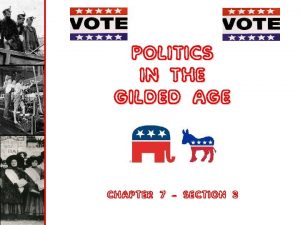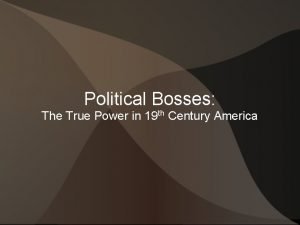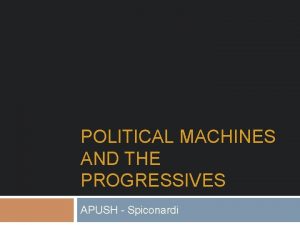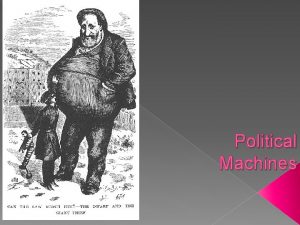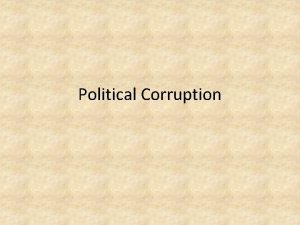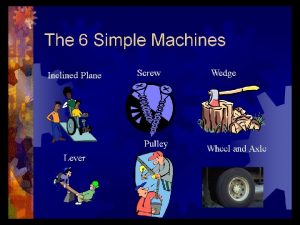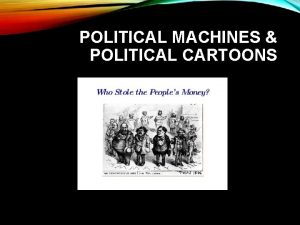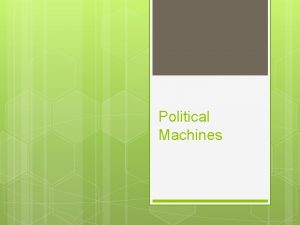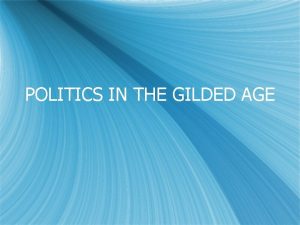City Politics The Machine City Machines Political Machines













- Slides: 13

City Politics The Machine

City Machines Political Machines existed since the beginning of the 19 th century when they played a role in the split of the Democratic Party of Andrew Jackson’s tenure in office. ® Political Machines offered services to voters and businesses in exchange for political support…they also intimidated ignorant immigrants. ®

How does the machine work? ® Hierarchy: Precinct captains ward bosses city boss…they controlled access to city jobs, business licenses, and influenced city courts and municipal agencies. ® Although these machine members were second or third generation immigrants themselves, they may not help fellow immigrants that do not support them.

The Machine and the Immigrant Machines also gave money toward the construction of hospitals and schools too…and assisted in the naturalization of immigrants, as well as assisted in the finding of jobs and housing for immigrants. ® Politics of the time mirrored the business community of the Gilded Age—Social Darwinism. ®

What do historians think? ® Historian Alan Dawley’s Struggles: Social Responsibility and the Liberal State he states “To the orthodox mind of the Gilded Age, the fact that wage earners teetered on the brink of poverty was a sign of their moral depravity. Combing the Puritan work ethic of individual salvation with…economics, Protestant economic doctrine held that responsibility for poverty lay not with the business cycle…but with the moral failure of the poor themselves to conduct proper family economy. ”

Famous Machines The political machines, especially in New York, led by Boss Tweed, made graft, the illegal use of political influence for personal gain. EX: A machine may hire a contractor, the contractor would then overcharge for a city project, and then the contractor would then “kickback” money to the machine. ®


Boss Tweed Between 1869 and 1871, Boss Tweed (a Democrat) led the corrupt Tweed Ring and also headed Tammany Hall, the Democratic mouthpiece in New York. They specialized in the graft/kickback game. ® One scheme had Tammany constructing the New York County Courthouse for 13 million dollars, but the bill actually cost $3 million…rest went to Tweed. ®


Thomas Nast: Thomas Nast helped to break this Tweed Ring by publishing cartoons depicting Tweed as a corrupt politician and inciting public outrage. ® In general, Nast was well known in his time for his political cartoons supporting American Indians, Chinese Americans and advocating abolition of slavery. ® Tweed was eventually arrested…and city corruption became a national issue. ®

National Politics Since Andrew Jackson patronage dominated national politics…patronage is the giving of government jobs to people who helped a candidate get elected (today we call it cronyism). ® Andrew Jackson called patronage the spoils system in politics. ®

Political Reformism Push for meritocracy and reform led to the Republican Rutherford B. Hayes backing through appointments and commissions a more balanced less partisan cabinet. WHY? : To extinguish corruption in local and national government. Hayes angered Republicans by firing of two top officials at a New York customs house. James Garfield and his VP Chester A. Arthur (the first a reformer, the second a Stalwart (or someone whom liked the spoils system). Hayes ended up supporting reform under Garfield’s leadership. This led to Garfield’s shooting by Charles Guiteau (a Stalwart lawyer turned down for an appointment) in 1881. ®

More Political Reforms ® Surprisingly, Arthur continues in Garfield’s footsteps and reforms Civil Service through the Pendleton Civil Service Act (1883), making the system more a meritocracy then before.
 Under the tammany tiger victim
Under the tammany tiger victim Members of the progressive movement generally supported
Members of the progressive movement generally supported Political machines/bosses
Political machines/bosses Gears sprockets pulleys
Gears sprockets pulleys Political machine apush
Political machine apush Whats a political machine
Whats a political machine Hát kết hợp bộ gõ cơ thể
Hát kết hợp bộ gõ cơ thể Lp html
Lp html Bổ thể
Bổ thể Tỉ lệ cơ thể trẻ em
Tỉ lệ cơ thể trẻ em Gấu đi như thế nào
Gấu đi như thế nào Chụp phim tư thế worms-breton
Chụp phim tư thế worms-breton Hát lên người ơi alleluia
Hát lên người ơi alleluia Các môn thể thao bắt đầu bằng tiếng bóng
Các môn thể thao bắt đầu bằng tiếng bóng
